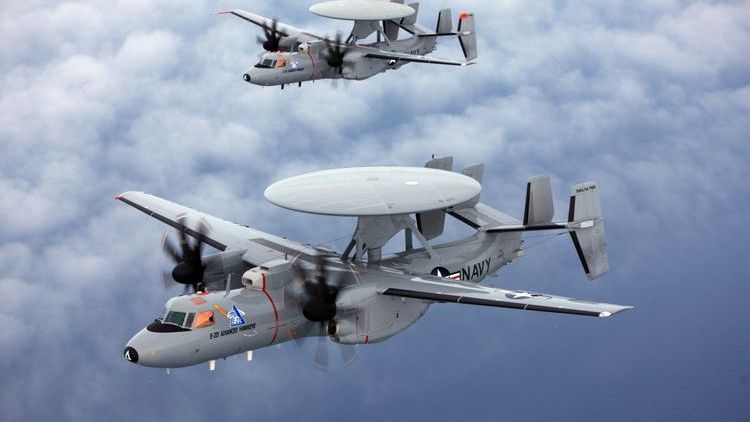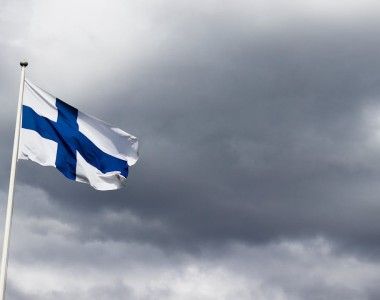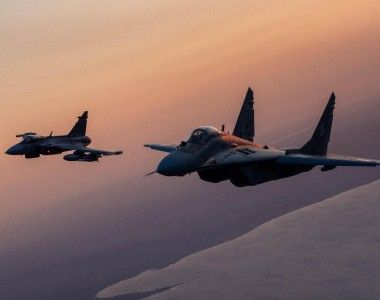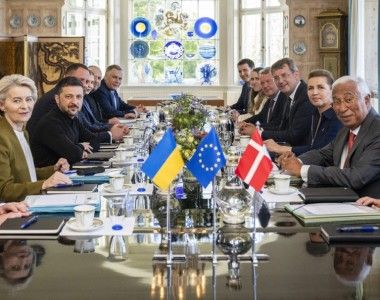Kathy Warden: Northrop Grumman to Expand Cooperation with Poland, including Munitions [INTERVIEW]

We are looking into some co-production relationships, particularly in the area of munitions to expand beyond where we are today in Poland specifically - as Kathy Warden, Northrop Grumman Chief Executive Officer told Defence24.pl in an interview. She also tells us what role Northrop Grumman could play in the European Sky Shield Initiative and how could the company support the security in Baltic Sea area.
Jędrzej Graf, Jakub Palowski: As we meet today in Warsaw, Poland is conducting a large-scale modernization project for its Armed Forces. It was started almost a decade ago, but it has been dramatically accelerated after Russia had launched the full-scale aggression against Ukraine in February 2022. Madam President, could you give an overview on the Northrop Grumman involvement in the Polish Armed Forces modernization efforts, today, tomorrow, and in future?
Kathy Warden, Northrop Grumman Chief Executive Officer: Our partnership with Poland goes back for decades, both from Northrop Grumman and the Orbital ATK perspective. The two companies combined in 2018, and in 2019 we have established a more significant presence in Poland, opening our office in Warsaw. So, our commitment to Poland predates the Russian full aggression against Ukraine and will extend well into the future.
We see a significant overlap between the portfolio of our products and the requirements for homeland defense in Poland. Most notably, what we are executing now is the IBCS product line that we are deploying for Medium Range Air Defense, and the future application for Short Range Air Defense is planned. But it doesn’t stop there. Surveillance, sensors, modern munitions, are a broad set of the opportunities that we see to support the strategy of the Polish government in defense.

Photo. Northrop Grumman
The Air Defense systems are in quite high demand now. Polish industry has quite an established relationship with Northrop Grumman in that area. What role do you see for the Polish industry for fulfilling the demand for the Air Defense systems, both in Poland and in other European countries?
In Poland specifically we have already been underway with the project to deploy IBCS and we have many suppliers and partners in the Polish industrial base working alongside us in the IBCS program. We have qualified over 40 suppliers in Poland, and those partnership are progressing well. We continue to be committed to the offset programs, both to meeting those commitments that are underway and establishing new ones as the work expands.

Photo. Northrop Grumman
What about developing a broader relationship with Poland, both with the industry, but also perhaps with the science? Northrop Grumman opened an office in Poland in 2019, what is the concept of Northrop Grumman presence in Poland from the company point of view?
When we think about the relationship with the industry in Poland, it is to ensure that there is good work content executed in Poland, particularly for the Integrated Air and Missile Defense programs. That includes producing some components of the system here in Poland, certainly supporting integration and also the training and deployment. So, it is a broad base set of relationships that we have established with the Polish industry.
And that is our model as we look to the future. You have mentioned co-production, and we are looking into some co-production relationships, particularly in the area of munitions to expand beyond where we are today in Poland specifically. And then our model everywhere in the world is to contribute to the communities where we operate, and that includes educational engagements. Our Poland office is participating in programs like „Vex Robotics” and going into the communities and schools to provide sponsorships to space camps. We always aim at getting the talent that we need in the local communities where we are operating, and creating that pipeline of people not just for our company, but also the other companies in the Polish industrial base.
I understand that you would like to use a similar industrial cooperation model, like the one is now applied in Air Defense, in other areas.
That is our model in all of the product areas. We know that it is important to have local content, so for each product line the extent to which we use local content may be slightly different. So, Integrated Air and Missile Defense is already underway, but when we look at munitions, co-production opportunities are still being explored.
I would like to have a question regarding the ammunition and the possible cooperation with Poland. It is considered a crucial and strategic area of the defense capability, and an important issue in NATO. Could you tell us more about this offer, is it a specific proposal or a broad concept?
We manufacture 120 mm munitions for all types of modern Main Battle Tanks used by the Polish Armed Forces, and this is one of the specific areas where we are looking at coproduction opportunities. We are looking first to operate under license for Poland’s sovereign defense. We feel that once coproduction is established, that it would be possible for Poland to export to other European countries. That process is already underway, and it is just an example, but it gives you a sense of how we work with other governments. Each time, we want to make sure that there is good industrial content from in-country sources.

Photo. Capt. Tobias Cukale, 4th Infantry Division; color-modified by Maj. Michael Brabner, USAOTC
Let us move to the technology development, R&D, a little bit. Conflict in Ukraine has shown us that European countries, NATO countries have some capability gaps. So, from this point of view, what is the Northrop Grumman approach to R&D, aimed at mitigating in those capability gaps in NATO countries?
When we think about the partnerships in Poland, we have found that there is very strong engineering and technology-based work here. We are optimistic that we can do more in an integrated way and develop new capabilities going forward. Our focus right now is taking more mature capabilities and deploying them quickly, and exploring co-production, and industrial cooperation opportunities. Co-development would be another step down the line, but as we develop relationships with so many Polish companies, we are gaining a better appreciation of what that would look like.
Another question I would like to have is about establishing supply chains. Not only war in Ukraine, but also recent conflict in Israel have demonstrated us how important it is to have robust and secure supply chains. What is the Northrop Grumman strategy to meet these challenges?
That is part of why we are looking at co-production relationships. We recognize we cannot and do not want to expand our full capacity out of any of the geographic regions. We would like to have our production capacity spread more broadly, both due to the security and resiliency perspective, and for ease of exports and logistics. So, all of that goes to our thinking on product lines. Particularly munitions, because they tend to be a little bit easier to set up for co-production and knowledge transfers in a relatively short timeline.
Regarding our more complex product lines, like IBCS, we still have industrial partners in the local government and industry, but they tend to be a bit more sophisticated and more engineering-related relationships.
Current war shows that the future battlefield will likely be full of drones and unmanned technologies, and Northrop Grumman has a large experience in that area. To what extent Northrop Grumman is working on that, and broadly speaking, to what extent Northrop Grumman is conducting long term R&D, including joint research and development with Poland?
We are working joint R&D. While we do not have anything like joint R&D active in Poland right now, we know how to do that, and we will be happy to explore those options over time. We do have partnerships in Europe that do co-development, we do have that in Italy, France, and UK. So, it is a model we are very comfortable and familiar with. We just have not gotten to that stage yet in Poland.
Ukraine has also shown that the technology development is taking place at a very high pace, as during wartime it is always happening faster, as it was for example during the World War 2. We have a broad discussion on that issue, including in the US, on whether both the contractors, industry is ready for implementing such a speedy development. Do you see any change of approach to R&D, in US, perhaps also in other countries, in response to the speed of threat development, not only drones but also other technologies?
We have definitely seen a shift toward more R&D spending in most of the countries we are operating, including the US, over the last six or seven years, and we expect that to continue. At the same time, now there is also a focus on procurement, ramping production, and we are doing that simultaneously.
The R&D of course focuses on technologies that will keep us competitive into the 2030s. Production has seen a near term focus to be able to replenish stockpiles of existing systems and address the more immediate needs. So, there are two different sets of priorities, both by our company and the governments we serve, but both are elevated at the moment.
We have already somehow covered Poland, but what is Northrop Grumman perspective on other countries in the region, such as Sweden, Finland, Czech Republic or Romania? All these countries are increasing their defense budgets. Is Northrop Grumman looking for opportunities in those countries?
Yes, I would like to emphasize that we are operating from Warsaw in our activities in both Central and Eastern Europe. And the enlargement of NATO is certainly an opportunity. And we believe that Finland and Sweden will look to the experience and leadership of Poland, particularly with the Integrated Air and Missile Defense. We have already seen that happened.
Poland was the first international customer for IBCS, partly because Poland had the fortitude to go with the US government, and the US government saw the need in Poland and accelerated the export license for us to work in Poland. Now Poland is the pathfinder for other European countries, which may lead them to come to Poland and see the system in operation, and we think that may be a tremendous benefit for the Polish industrial base where we have already established relationships, and also for those countries.
What is your approach to the European Sky Shield Initiative, a common Air and Missile Defense project led by Germany? Some of the opinions we have heard on that highlighted that in the next stage of the project, there will be a challenge to integrate, joint various national systems to one enhanced European-NATO systems.
I absolutely think that Integrated Air and Missile Defense works best when it is integrated across nations. It is an open architecture system that allows and actually facilitates integration of sovereign capabilities and can be connected across nations. That is the point for the U.S. as we work with allies, that a single system like IBCS makes that integration easier for us to share a common operating picture to defend the airspace.
So, I think the vision for that project can easily be filled with IBCS. And Poland is already able to integrate into such an architecture because Poland has chosen IBCS.

Also, the protection and defense of Baltic Sea area is and will remain a priority for the Polish government. After Finland and Sweden joined NATO, it further gained importance as a tension area between the Alliance and Russia, and Baltic is also important for energy supplies for Poland. Do you see, as Northrop Grumman, a potential to involve new technologies to increase the protection of Baltic Sea region?
We do see such a potential. One of the things I am most excited about, and I believe provides an important surveillance capability is our E-2D Advanced Hawkeye program. This system has been built for U.S. Navy and it has also been provided to France and Japan in foreign military sales (FMS) projects. It has also shown its value in providing intelligence to Ukraine through surveillance near the border.
So, E-2D would be a very important addition to Baltic Sea security and of course we are talking to the Polish government about this capability. It is just one example of the systems we may provide.
Thank you for the conversation.



